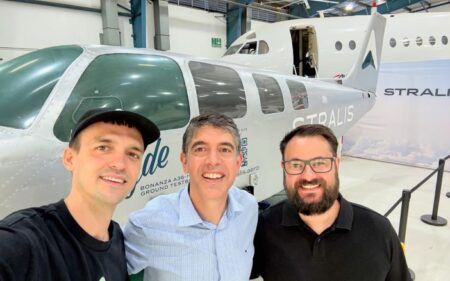Engineers at Wright Electric have successfully tested its 2MW motor at a simulated atmosphere equivalent to 43,000ft of altitude in its laboratory without Potential Discharge.
US-based Wright plans to convert BAe 146 regional aircraft with an electric propulsion system it is developing. The Wright Spirit will be capable of transporting up to 100-passengers for one-hour flights and is planned to fly for the first time in 2026.
The company, which was founded in 2016 is then targeting a 2030 entry into service for its Wright 1, a 186-seat airliner with an 800 mile (1.300km) range.
Wright Electric engineers have been focused on developing its megawatt-scale electric propulsion system for aircraft since early 2020 when the company moved into new premises in Albany, New York. The motor Potential Discharge (PD) test is the latest milestone in the development of the propulsion system – previous successful tests announced include a high-efficiency, high-power density inverter.
Wright is also working on high-capacity batteries, it says will be four times more energy dense than current generation battery packs and be ready by 2027.
The motor PD test was conducted at 1,000 volts and sets the stage for simulated altitude testing at NASA’s Electric Aircraft Testbed (NEAT) in in Sandusky, Ohio later this year, said Wright.
Achieving zero Potential Discharge (PD) at this altitude is a significant step forward in realizing Wright’s goal of zero emissions on flights shorter than 800 miles.
PD-free performance is crucial to operating electric motors on aircraft. When electric motors run at high voltages, the insulation surrounding the conductive components is subjected to electric stress.
Over time, stress may weaken the insulation, leading to PD. Potential Discharge can further accelerate the degradation of insulation, potentially causing motor failure among other safety concerns.
As altitude increases, the voltage level needed to cause PD decreases. This means PD is not an issue for many electric aircraft under development, such as eVTOL aircraft, which cruise around 3,000ft – typical insulation is sufficient.
However. Wright Electric is developing motors and inverters for commercial aircraft that typically cruise at 36,000 feet, making air taxi solutions impractical.
Jeff Engler, founder and CEO of Wright Electric said, “45% of all aviation emissions are from single-aisle flights. By proving those flights can be flown without potential discharge, we are one step closer to eliminating this massive form of pollution.”





